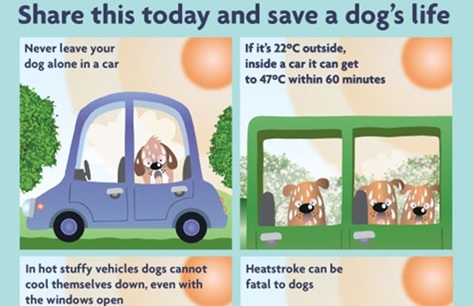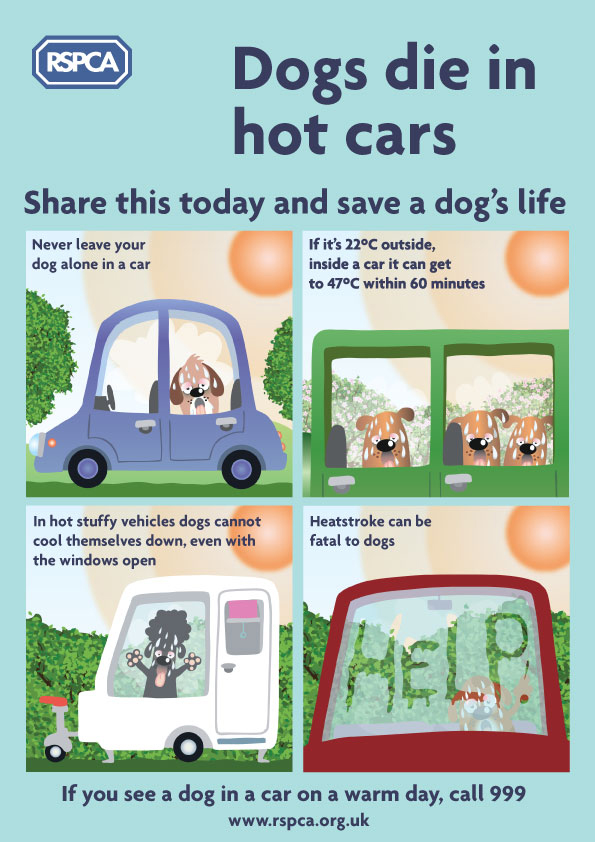Summer can be a wonderful season, with lots of time spent outside enjoying the sunshine and warm weather. Whilst many of us like to enjoy the sunshine and hot weather, we should make sure we do it safely and remember our cherished companions are often vulnerable to heat and rely on pet owners taking responsibility in protecting them when we are experiencing extreme heat.
A little food for thought...
*Never leave your dog in a car on a warm day. If you see a dog in distress in a hot car, Dial 999
With the current bout of warm weather and summer fast approaching it is important to remember that dogs die in hot cars.
For more information on:
- What to do if you see a dog in a car on a warm day
- How to help a dog in a hot car
Click the link here: https://www.rspca.org.uk/adviceandwelfare/pets/dogs/health/dogsinhotcars
**Summer is nearly here, and the hot weather invites everyone to spend more time outside. However, walking your dog at this time of year can be quite dangerous in certain circumstances. As an owner you need to be vigilant to ensure your dog is always protected.
Sunstroke, overheating and sunburn
Dogs are susceptible to sunburn, just like humans. You would be forgiven for thinking their thick coats protect them against the sun’s rays, but this is not always the case. Although it is true the coat blocks rays to a certain extent, the skin underneath can still get severely burnt. Areas that aren’t protected by a thick layer of fur such as the nose or stomach are even more at risk. To combat sunburn, rub some sun cream into your dog’s most vulnerable areas, and ensure they don’t stay out in the sun too long. Ask your vet about the best type to use.
Dogs are also at risk of suffering from sunstroke, which happens when they are unable to effectively regulate their body temperature. They are only able to sweat through their paws rather than their entire body, unlike humans, so they need to expel heat through panting. However, this is ineffective if they are drawing in warmer air than they are releasing. Their fur coats only add to the problem by retaining heat and preventing its expulsion.
You need to watch out for signs that your dog is overheating or suffering from sunstroke. These include excessive panting, pale or dry gums, hyperventilation, increased salivation, diarrhoea, vomiting, an increased heartbeat, weakness, confusion and also rectal bleeding.
Act immediately if your dog begins to show any of these symptoms. Take them to a shaded area so they can start to cool down, and if possible, use a fan to reduce their temperature further. Place cool, wet towels on their body, especially the neck, under the armpits and between the hind legs. You can also wet their ears and paw pads. Provide your pet with water but don’t allow them to gulp it down too quickly, as they may suck it into the lungs. If they won’t drink, wet their tongue with the water instead. Whatever you do, don’t give a dog in this situation any ice, as it could shock the system. Take them to a vet as quickly as possible, and call beforehand so they can adequately prepare for an examination.
Dehydration
It can be easy for your pet to become dehydrated whilst walking. This is especially likely if there is no shade for them to cool down in and they have been on a long walk-in high heat. Signs of dehydration include sunken eyes, loss of appetite, lethargy, excessive drooling and urination, loose skin, weak pulse, a dry mouth and depression, amongst others.
You need to ensure enough fresh, cool water is available to keep them hydrated, so leave multiple bowls around the house. If they are going to be left outside for a while, make sure there are enough shaded areas and water sources. Use sturdy bowls to deter spillages and to prevent them from getting knocked over. When supervised, leave a paddling pool for your dog to cool off in should they need to. Always bring water whenever you go out walking, and remember to give them some at regular intervals so they can remain hydrated throughout the day.
Burnt feet
You will forget how hot tar can become underfoot, but dogs will feel the heat on the pads of their paws. Pavements, cobbles and other areas can be uncomfortably hot for your dog to tread on during summer, and may even burn their feet.
To avoid any problems, change the time of day you walk your dog. Don’t take them out at midday when the sun is highest in the sky, as this is the hottest period. Instead, walk them early in the morning or later in the evening when the ground is cooler. You could also buy some boots for your dog that would protect their feet.
Parasites, insects and plants
Summer is the optimum time for parasites to multiply and potentially harm your pet. Ticks hide in long grass and mosquitoes feed on the blood of their host. These are just two of the parasites that may be encountered when out walking, but there are many more. They can transmit infection, disease and other parasites such as worms, so always be mindful of any potential contact with them.
Furthermore, insects and larger animals could sting or bite your dog when out walking. Bees, wasps and horse flies are examples of insects they may come across. They can also be bitten by a grass snake if they unwittingly disturb one, although this is uncommon.
Various flowers and plants in bloom during the spring and summer months can also pose a threat to your pet should they eat them. You need to supervise carefully when out walking by making sure they don’t ingest any flowers or plants that will harm them, or get bitten or stung by any insects. Should this happen, take your pet to the vet immediately. Some flowers are poisonous, whilst your pet may experience an allergic reaction to some insect bites or stings. Even though they may not exhibit signs immediately you don’t want to take any chances, and symptoms may only begin to appear sometime later.
* Information from the RSPA
**Elena Barnard Animal Friends Pet Insurance









